Textualities (DAILY thought splats)
Follow @neuage Tweet to @neuage @ AMAZON
This is our final instalment of the three- or four-part series on our three-month European whatsup trip. The main focal points being The Netherlands, Berlin, Northern Spain, with a yarn or two about the UK (London, Horsham, Brighton, Portsmouth, and of course our mini-cruise, the ferry).
Noja
Lovely overnight on the ferry. Pilar and Josera met us; the ferry was an hour late arriving in Santander, Spain. During the night it was quite rough. Little bit nervous a few times – have to confess.Our flat is nice, strangely located in an area where people have second homes, so this time of the year almost every apartment block is all boarded up. Nice and quiet! Though shops are still open (‘Lupa’, the local supermarket). No one speaks English, but they seem friendly, though no one smiles at you in the street (very unlike Denmark) We ate croissants at the local café.
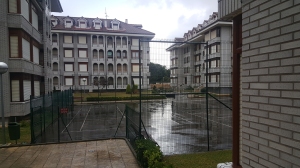 Our hosts, Pilar and Josera, collected us from the ferry and drove close to the hour to our new home. As Narda pointed out above, we are the only ones here. The owners live in Bilbao another hour away. For a few miles in each direction there are rows of houses as above. We have a tennis court in front of our door. We will get back to our world of tennis further on. It is a bit spooky with no one around. On weekends a few people would show up, during the week, we were the masters of our surroundings. I liked it. Like one of those end-of-the -world films where two survive. We are them.
Our hosts, Pilar and Josera, collected us from the ferry and drove close to the hour to our new home. As Narda pointed out above, we are the only ones here. The owners live in Bilbao another hour away. For a few miles in each direction there are rows of houses as above. We have a tennis court in front of our door. We will get back to our world of tennis further on. It is a bit spooky with no one around. On weekends a few people would show up, during the week, we were the masters of our surroundings. I liked it. Like one of those end-of-the -world films where two survive. We are them.But perhaps you survived too as you are reading this.
The flat was well furnished and everything we needed was there.
We enjoyed walks in the small town of Noja – pronounced No gHa, (with the G sounding like 'gezellig' in Dutch; not so useful for most of you) and the seaside views a block away. Noja is in the autonomous community of Cantabria. Cantabria is the northern section of Spain that borders the sea. We stayed within Cantabria for the most part, except, for when we travelled a bit to the east to the Basque area.
 While snooping through the flat we had for the next three weeks we found tennis rackets and balls. Outside the building was a tennis court. Putting all this exciting new information together we decided to play tennis. Nothing extraordinary about that, except, neither of us had played before. We went onto the court, had a bit of a look-around the neighbourhood, saw no one was in any of the flats, to possibly watch us, and off we were. Back and forth, back and forth. I think that first day, well, the whole first 27-minutes, of our fierce rivalry, our record volley in a row, before hitting the net, putting it over the fence, or watching it half-heartily bounce into the next court, was three times, back and forth over that bloody net. I never realised how hard it was to get a stupid little ball, hitting it with a large surface, would be so hard. Knowing we had done our exercise for the day we went back into our cosy flat, had coffee, looked at pamphlets, brochures, and webpages to plot our exploration of the continent, or at least Northern Spain.
While snooping through the flat we had for the next three weeks we found tennis rackets and balls. Outside the building was a tennis court. Putting all this exciting new information together we decided to play tennis. Nothing extraordinary about that, except, neither of us had played before. We went onto the court, had a bit of a look-around the neighbourhood, saw no one was in any of the flats, to possibly watch us, and off we were. Back and forth, back and forth. I think that first day, well, the whole first 27-minutes, of our fierce rivalry, our record volley in a row, before hitting the net, putting it over the fence, or watching it half-heartily bounce into the next court, was three times, back and forth over that bloody net. I never realised how hard it was to get a stupid little ball, hitting it with a large surface, would be so hard. Knowing we had done our exercise for the day we went back into our cosy flat, had coffee, looked at pamphlets, brochures, and webpages to plot our exploration of the continent, or at least Northern Spain.We tho
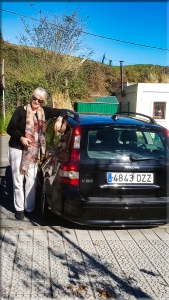 ught we would put off driving for another day, as we had not driven in Europe yet on our three-month trip. Now, back here in Australia, I forget which side of the road who drives on what, but I think it was either the same or different than Australia. In Berlin, we had use of a car, but chose to ride bikes the whole time, the same in The Netherlands, and UK. I am so used to Narda yelling out that I am on the wrong side of the road when riding a bike, it all just becomes one big blurry, ‘you’re on the wrong side, still’.
ught we would put off driving for another day, as we had not driven in Europe yet on our three-month trip. Now, back here in Australia, I forget which side of the road who drives on what, but I think it was either the same or different than Australia. In Berlin, we had use of a car, but chose to ride bikes the whole time, the same in The Netherlands, and UK. I am so used to Narda yelling out that I am on the wrong side of the road when riding a bike, it all just becomes one big blurry, ‘you’re on the wrong side, still’.Being our first day, recovered from our tennis tournament of geriatric-bouncy-poo, being hungry and in need of substance, we Google-mapped the nearest grocery story, ten-minute walk away, and were off. There are three food stores in Noja: Lupa Supermercados, Coviran, and the Carrefour Express. We went to Coviran first as that was nearest but it was small, so we got only a few things. Our market of choice became the largest of them all, Lupa. We both like foreign supermarkets. Our favourite is Jumbo, in The Netherlands, but any foreign market is fun, trying to figure what dangerous items they have slipped into the ingredients section. Of course, in places like Spain, India, France, well anywhere we don’t know the language, it is quite the challenge, so we just go by the pictures on the package and hope our bodies can separate the righteous items from the pretending-to-be-food items. Throw in my low-carb-vegetarian-make-that-organic diet, and the challenge becomes even greater. Nevertheless, we got home with a couple of good stuff.
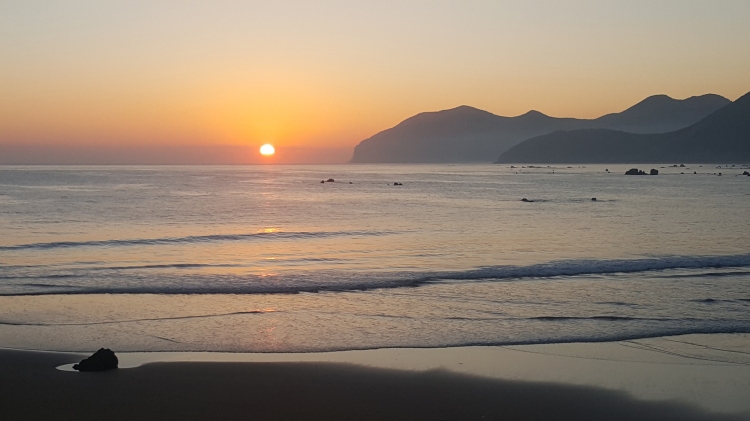 Santona
Santona
After settling in, learning tennis, exploring Noja from side to side, and having now been in Spain for a whole day we decided to give driving the car left for us a go. Narda being born in Holland, gave her a right-of-passage to be the first to drive in Europe. We are used to our truck back in Australia and driving, I think it is on the left side of the road, so having a good-looking Volvo station wagon waiting for us and driving on the right side seemed doable. Me, being the Yank, driving on the right side as we do, it should have been me driving first.The car is a lovely Volvo, complete with leather seats, and great to drive. Our first venture out was to a beach town called Isla, where we tried the potato croquettes. (I added chicken).The scenery is spectacular, cliffs, small beaches, inlets, rocks. Then we drove on to the lovely town of Santona, where the first thing that you notice is a strong smell of fish; that is if you take the backroad, which we did. Apparently it's anchovies, which are caught, washed, aged, cured and dried. Folks in Santona are the experts in this.
 Santona became our local ‘big’ town to troll. Via the internet, there are eleven-thousand people in the area, http://www.aytosantona.org/. If there is such a thing as a typical Spanish town, this would be it. We found a printer for Narda to print photos for her travel-book, some of which I am borrowing passages of for this blog. Santona has the sea on one side and mountains in back, or front if you are facing that way then the sea would be in the back. I liked apartments built into the mountain, as below, facing the sea.
Santona became our local ‘big’ town to troll. Via the internet, there are eleven-thousand people in the area, http://www.aytosantona.org/. If there is such a thing as a typical Spanish town, this would be it. We found a printer for Narda to print photos for her travel-book, some of which I am borrowing passages of for this blog. Santona has the sea on one side and mountains in back, or front if you are facing that way then the sea would be in the back. I liked apartments built into the mountain, as below, facing the sea.The Spanish countryside is beautiful. The first town after Noja is Isla, a copy of Noja, with lots of holiday apartment buildings. If you are in town, we found lunch at Hotel Alfar tasty and affordable, with croquettes, though probably not low-carb. http://www.alfarhotel.com/ I did find the word for vegetarian, so, probably what I ate was not once an animal. We were there at low-tide, with what was becoming our often-viewed sight of the sea from many towns and angles. After Isla we went through the towns of Argons and Castillo, both smaller than Noja, beach-side tourist enclaves, on the way to downtown Santona. The whole trip is about fifteen minutes, if not stopping, or getting lost, which, surprisingly, we do.
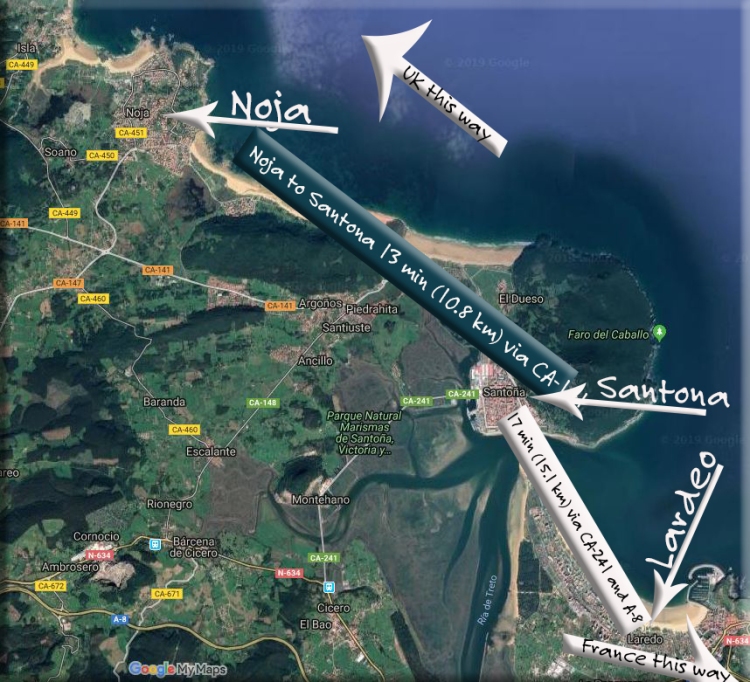 However, we liked to stop, take photos, say ‘wow’, and continue to whatever our day was to bring us.
However, we liked to stop, take photos, say ‘wow’, and continue to whatever our day was to bring us.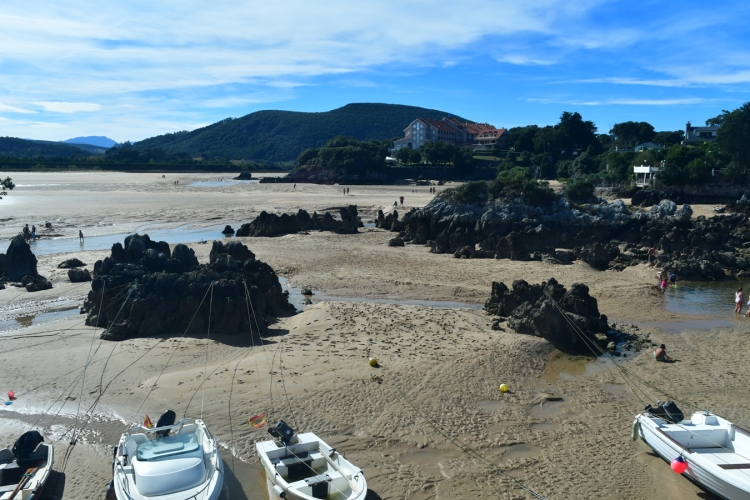 Surprisingly, to us, was that there was snow on the nearby mountains – in October.
Surprisingly, to us, was that there was snow on the nearby mountains – in October.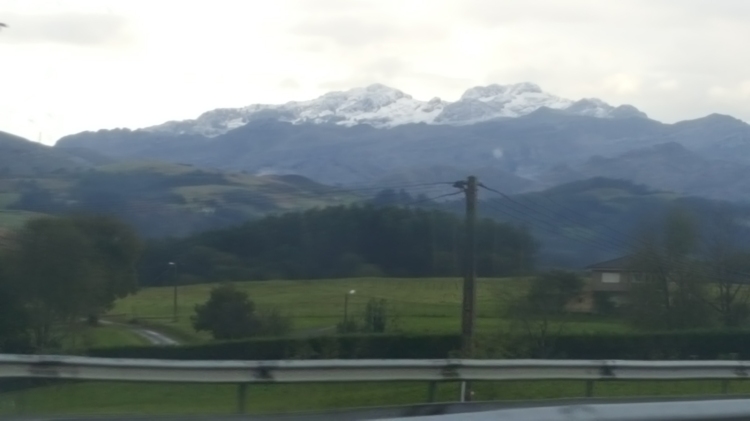 There was some event in our town on the weekend. Tents were put up, people mingled, and there was a day and evening of music, with bands, cooking shows, and lots of foreign stuff happening. We made a short clip to give an idea of the tent and music - http://tiny.cc/tc7c3y.
There was some event in our town on the weekend. Tents were put up, people mingled, and there was a day and evening of music, with bands, cooking shows, and lots of foreign stuff happening. We made a short clip to give an idea of the tent and music - http://tiny.cc/tc7c3y.[embed]https://www.youtube.com/watch?v=Rnmlv-lK2Tk&feature=youtu.be[/embed]
Wow, talk about being clueless, I just looked up that weekend in Google, trying to piece together why there was such much merriment going on;
“Hispanic Day (Día de la Hispanidad) or National Day (Fiesta Nacional de España) is an annual national public holiday in Spain on October 12. It commemorates when Christopher Columbus first set foot in the Americas in 1492.”
Ah, something just went off in my brain-stem. When we lived in New York City, there was Columbus Day Weekend. We would go to Fifth Avenue and watch the parade. I have videos of it on YouTube, for example, you don’t want to go past this Narda/Terrell classic @ http://tiny.cc/v2mb3y ‘Columbus Day Parade New York City 2006’.
[embed]https://www.youtube.com/watch?v=WAhu92wapKg[/embed]
In fact, what I wrote back then about the parade was, “Not a very good parade, surely not up to New York City standards. Most of the parade was very disorganised with people wandering around as if they were in the parade. Some of the floats were OK but overall very budget”. That somewhat sums up the Columbus Weekend in Noja, except, there were no floats, but it all did seem quite random. Of course, not reading/speaking Spanish we had no idea to begin with.
For a 20-second clip of us stuck in a herd of cows in Northern Spain http://tiny.cc/5inb3y on one of our random-day-wanders through the Spanish countryside.
[embed]https://www.youtube.com/watch?v=zuOQUvvviho[/embed]
Most of our days were highlighted by sleeping in, playing a spot of tennis, going for a few hours drive around the local areas, taking an afternoon nap, and watching our Netflix series in the evening. The bit of a nap is not because we are as old as the hills, it is that is what the Spanish people do. From 2 – 3 or was it 4? Shops close, people go wherever they go, presumably a glass of wine and a nap, then have dinner between 9 – 11 pm. That is their day. We tweaked their day by having dinner at 6 or 7 and to sleep by 10, old-as-the-hills.
Laredo
Laredo, 45-minutes away was another groovy Spanish town we visited a couple of times. Laredo is slightly larger than Santona. It is a beach city with one of Cantabria's longest and busiest sandy stretches. It had a very old section, dating back to Roman times. Not current Roman but old old Roman times. As with elsewhere in Spain, the folks disappear in the afternoon. We wandered around the whole old section for hours without seeing anyone. As it was siesta time, we didn’t get into the 13th-century Gothic Iglesia de Santa María cathedral. I got lots of photos which are posted somewhere.
Laredo is slightly larger than Santona. It is a beach city with one of Cantabria's longest and busiest sandy stretches. It had a very old section, dating back to Roman times. Not current Roman but old old Roman times. As with elsewhere in Spain, the folks disappear in the afternoon. We wandered around the whole old section for hours without seeing anyone. As it was siesta time, we didn’t get into the 13th-century Gothic Iglesia de Santa María cathedral. I got lots of photos which are posted somewhere.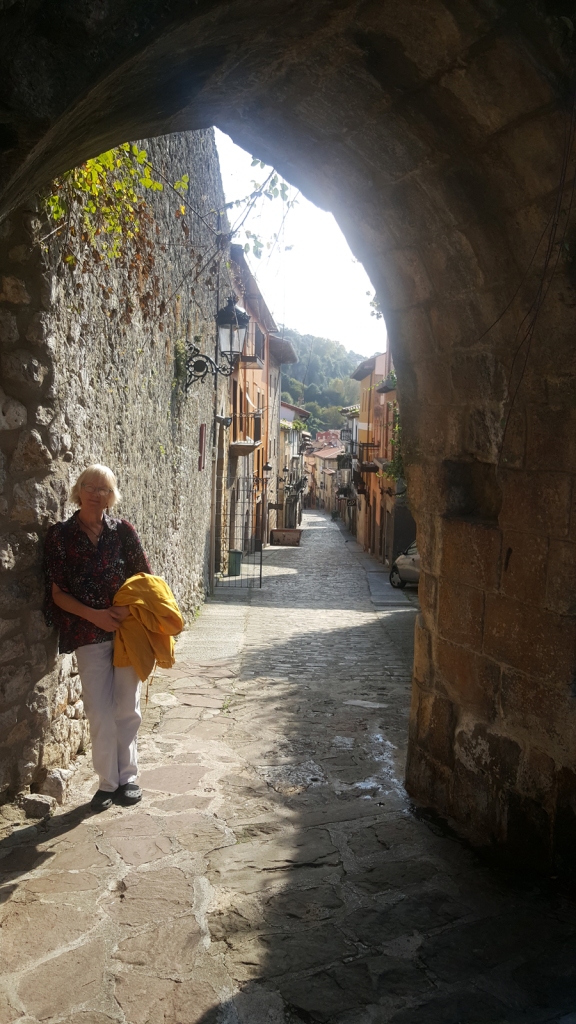
At the end of a street we came across the tunnel leading through La Atalaya hill to the sea. I can't find my notes on this tunnel or information on the web, though I found it was built in the 19th century, no doubt, in anticipation of our arrival in the future.
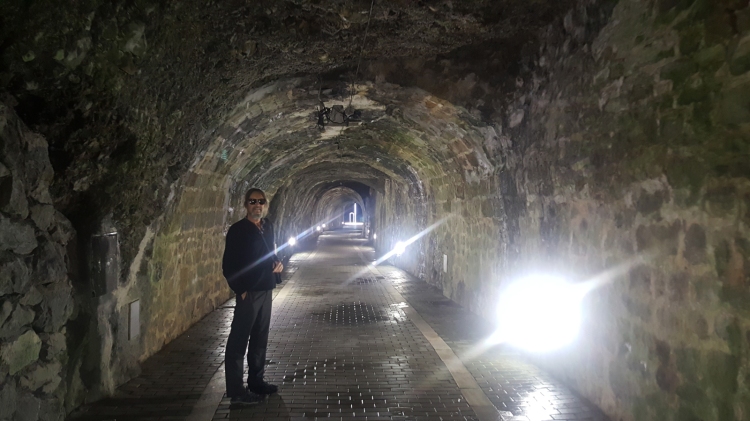
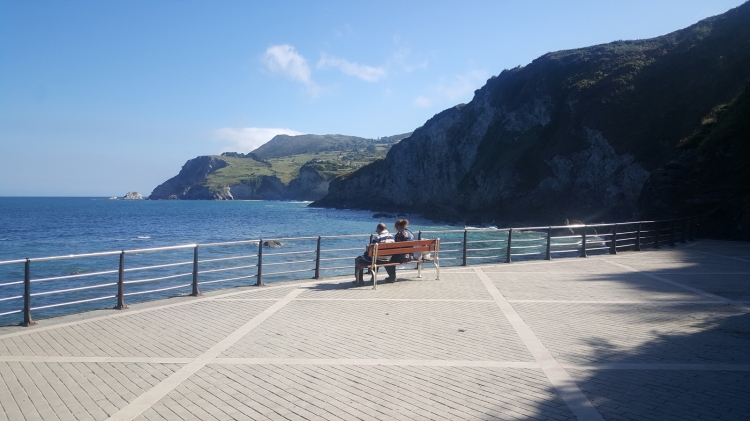 For my USA mates, it is the sister city of Laredo, Texas; there is nothing in common, oh wait, both places are Spanish speaking and maybe even both have a tunnel. I won’t comment why there would be a tunnel between Laredo and Mexico though.
For my USA mates, it is the sister city of Laredo, Texas; there is nothing in common, oh wait, both places are Spanish speaking and maybe even both have a tunnel. I won’t comment why there would be a tunnel between Laredo and Mexico though.When in Spain, eat at tapas bars. A tapa is an appetizer or snack in Spanish cuisine and translates to small portion of any kind of Spanish cuisine. It became the way of eating in the afternoon. We didn’t write down the name of the tapas bar in Laredo, but you can find it. It is the only place open in the afternoon at the start of the old town.

We have a short clip, with a minute slideshow of photos from our day in Laredo at https://tinyurl.com/y426xbce
[embed]https://www.youtube.com/watch?v=0C7cOFcYuJw&feature=youtu.be[/embed]
Santander
We drove the couple of hours over to the port city of Santander. Santander is where we arrived on our ferry from the UK, the Bay of Santander, the week before. It is the capital of Cantabria, the region we were hanging out in. The main attraction here is the Palacio de la Magdalena. Built 1909 – 1911 for the Spanish Royal Family. We walked around the palace, waved to the sea, looked for a loo and went back to our car, had lunch in the old section of Santander, drove home.The only photo out of a hundred that summed up my day was watching a millennial preening in front of the palace. If you want to see what I said about this photo, go to the twitter feeds for it: http://tiny.cc/pmmh3y and, http://tiny.cc/6nmh3y

If you are into exploration, driving through random towns, seeing the countryside, is as interesting as the larger cities. For example,
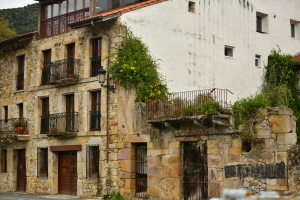
I don’t have the name of this town, but there were so many with the whole place being old. Being old, we like old, quaint, no big-box stores or fast-food shops, just pubs serving wonderful tapas for meals.
San Sebastian Donostia
San Sebastian is a resort town on the Bay of Biscay in Spain’s mountainous Basque Country: driving for a few hours twards the French border. There are four languages spoken in San Sebastian: Basque, French, Spanish, English. For example, from a sign we saw four languages on most signs.
There are four languages spoken in San Sebastian: Basque, French, Spanish, English. For example, from a sign we saw four languages on most signs.
The Basque language, and people, are fascinating. We learned something about the Basque culture from our host, who is Basque. He is the principal in a school system, where the students only speak Basque (or Euskara). They are a strong, good looking people, very proud of their extensive history and heritage. To our ignorant ears, the language sounds very different from Spanish. Both the French and the Spanish have tried to supress their language and culture, but now in more recent times, they enjoy more autonomy.
We booked into Pension San Martin and spent two nights, three days in San Sebastián. The hotel was a one-star pension, in the centre of town. For one-star it was very comfortable, and a good choice. Trip Advisor gave it a 4.5-star rating. We strolled around town our first day walking along the grand beach of Playa de la Concha, then into the old quarters for a great meal of tapas.
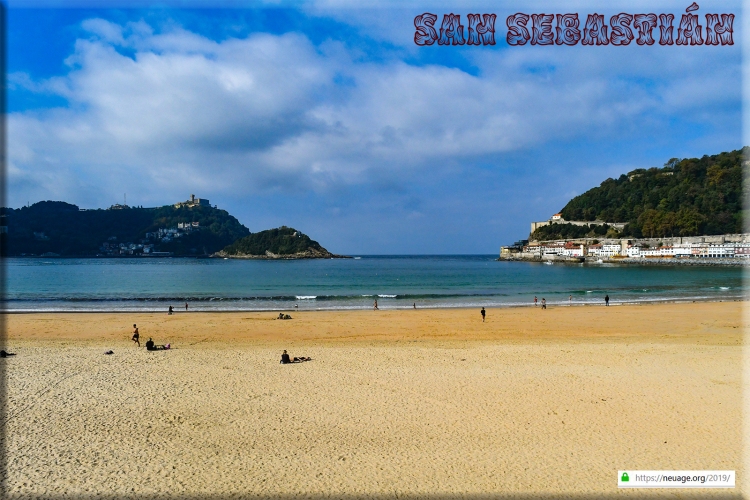 One of the things I discovered was that there was a tram-line that went to France. Holy Cow, what a great idea. How about going to France for lunch? We took the half-hour tram/train from San Sebastián to Henday. Ticket costs 2.55 Eur per person ($3 USD, $4 Australian); deal of the day. It is on a narrow-gauge train track, looks like a commuter train, but locals seem to refer to it as a tram.
One of the things I discovered was that there was a tram-line that went to France. Holy Cow, what a great idea. How about going to France for lunch? We took the half-hour tram/train from San Sebastián to Henday. Ticket costs 2.55 Eur per person ($3 USD, $4 Australian); deal of the day. It is on a narrow-gauge train track, looks like a commuter train, but locals seem to refer to it as a tram. When we got to the French train station, we saw that there was a train that went to Paris that took five and a half hours. We were so tempted to wait a few hours and go, but; 1. We are not good at waiting 2. Our stuff was back at the one-star hotel in San Sebastián. 3. One of us was practical enough, in that particular moment, to suggest, perhaps we shouldn’t do that. There was street fair going on in Henday, we had lunch, walked heaps, through the old section, checked out the views from some hip-looking lookout, and took the train back.
When we got to the French train station, we saw that there was a train that went to Paris that took five and a half hours. We were so tempted to wait a few hours and go, but; 1. We are not good at waiting 2. Our stuff was back at the one-star hotel in San Sebastián. 3. One of us was practical enough, in that particular moment, to suggest, perhaps we shouldn’t do that. There was street fair going on in Henday, we had lunch, walked heaps, through the old section, checked out the views from some hip-looking lookout, and took the train back.[caption id="attachment_22693" align="alignleft" width="300"]
 morning tea, Henday, France[/caption]On our last day in groovy San Sebastián we took the funicular railway (cable car) to the top of Monte Igueldo, with its sweeping view over stuff.
morning tea, Henday, France[/caption]On our last day in groovy San Sebastián we took the funicular railway (cable car) to the top of Monte Igueldo, with its sweeping view over stuff.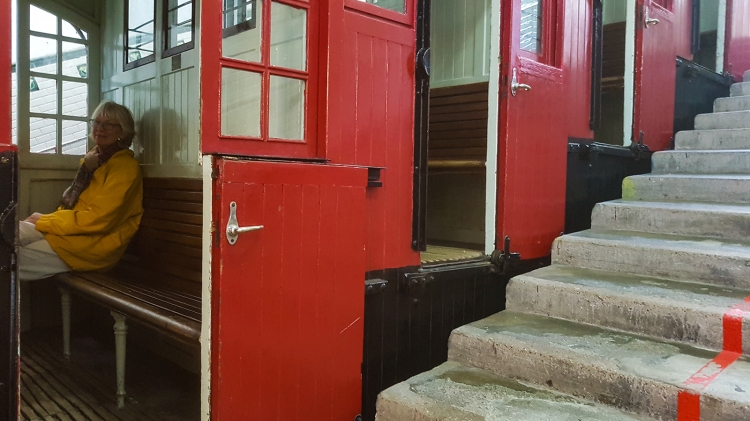
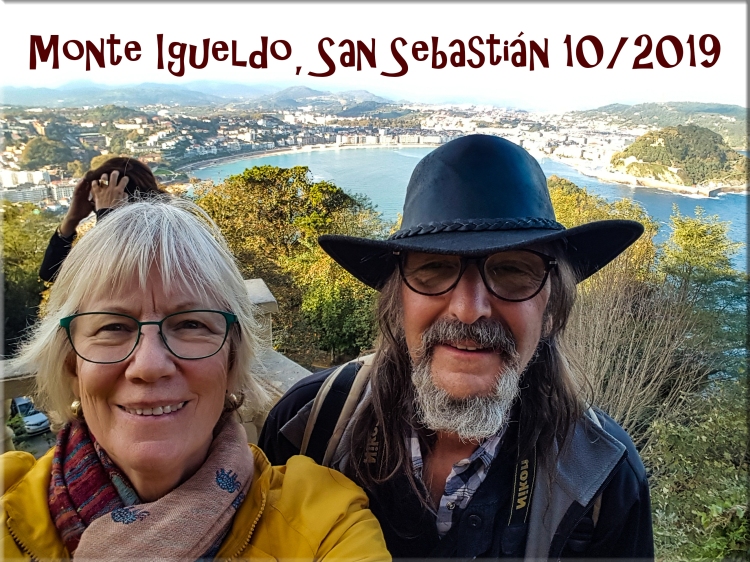 Along the coast, before the cable car we watched surfers riding alongside the village wall. It seemed quite perilous but no one came to grief.
Along the coast, before the cable car we watched surfers riding alongside the village wall. It seemed quite perilous but no one came to grief.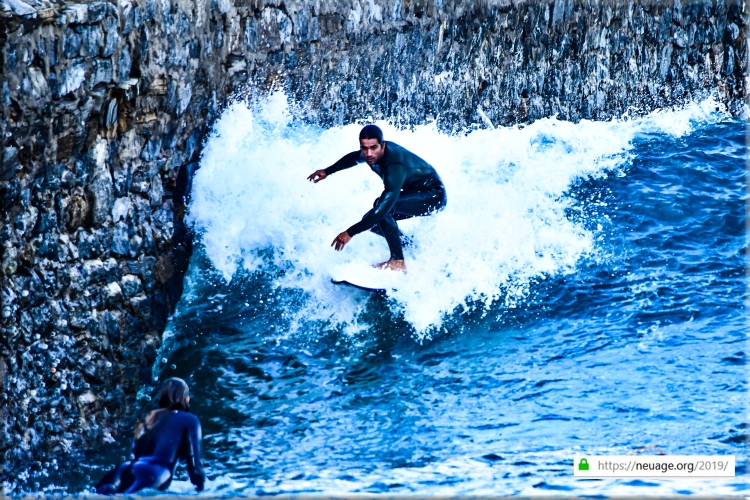 If we get back to this part of Spain, Donostia, San Sebastián we will definitely craft a longer stay; next time we will bring an overnight bag, take that train to Paris and grab one of those les cuisses de grenouille, les escargots, la tête de veau; oh wait! I am a vegetarian. Bring on Flamiche and other groovy stuff.
If we get back to this part of Spain, Donostia, San Sebastián we will definitely craft a longer stay; next time we will bring an overnight bag, take that train to Paris and grab one of those les cuisses de grenouille, les escargots, la tête de veau; oh wait! I am a vegetarian. Bring on Flamiche and other groovy stuff. We drove around the countryside some days, including going down to Solares to see Naturaleza de Cabárceno Park, which is a nice old town folks go to for one reason, the open animal zoo. It was once a large iron mine and after the iron business went elsewhere some adventuresome folks saw it as a big area to toss in a bunch of wild animals. Being cheapskates we drove around part of the park, walked through a gate as if we belonged and waved to various animals. None waved back, however, it was a great, inexpensive day. Yes, we even took a flask of coffee and lunch with us. How to see the world on pennies a day – we will be your guides. Reviews of it are in the five-star range, folks saying it is one of the best animal places in Europe. But really, park in the free car park in town, walk through the gate, around the enclosure and it is all free. I think it is because most people drive in to park, and they get stopped to pay for their ticket and to park, well, and to go in the actual park. Oh boy, they have an area to see kangaroos. We see them as much as we want to, on our walks behind our house, laying alongside the road (roadkill), even hopping down the road. But if you are from one of those no-kangaroo places in sight then it may be interesting. ‘The natural park is home to a hundred animal species from five continents living in semi-free conditions, which are distributed in large enclosures where one or more species coexist. Almost all of them trigger fights and mating season struggles for control of females (sounds like my neighbourhood). More than 20 kilometres (12 mi) of roads cross the park, leading to gorges, lakes, and rock figures.’ You can ride a cable car over the top if you have the cash.
We drove around the countryside some days, including going down to Solares to see Naturaleza de Cabárceno Park, which is a nice old town folks go to for one reason, the open animal zoo. It was once a large iron mine and after the iron business went elsewhere some adventuresome folks saw it as a big area to toss in a bunch of wild animals. Being cheapskates we drove around part of the park, walked through a gate as if we belonged and waved to various animals. None waved back, however, it was a great, inexpensive day. Yes, we even took a flask of coffee and lunch with us. How to see the world on pennies a day – we will be your guides. Reviews of it are in the five-star range, folks saying it is one of the best animal places in Europe. But really, park in the free car park in town, walk through the gate, around the enclosure and it is all free. I think it is because most people drive in to park, and they get stopped to pay for their ticket and to park, well, and to go in the actual park. Oh boy, they have an area to see kangaroos. We see them as much as we want to, on our walks behind our house, laying alongside the road (roadkill), even hopping down the road. But if you are from one of those no-kangaroo places in sight then it may be interesting. ‘The natural park is home to a hundred animal species from five continents living in semi-free conditions, which are distributed in large enclosures where one or more species coexist. Almost all of them trigger fights and mating season struggles for control of females (sounds like my neighbourhood). More than 20 kilometres (12 mi) of roads cross the park, leading to gorges, lakes, and rock figures.’ You can ride a cable car over the top if you have the cash.
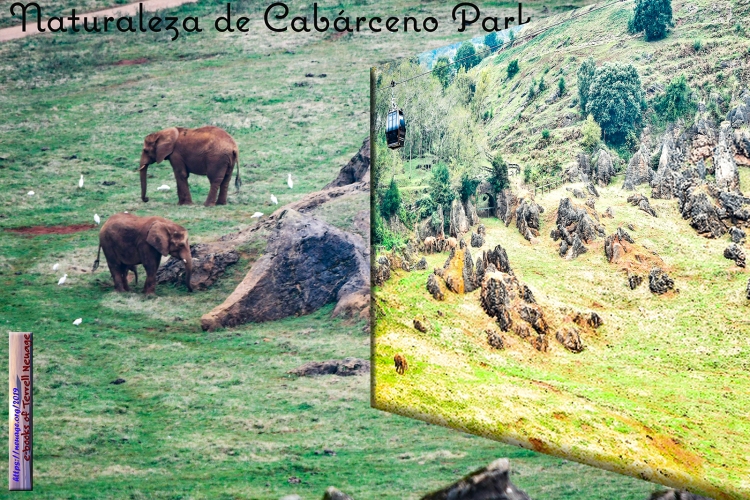 Bilbao
Bilbao
A highlight was Bilbao. We had wanted to see The Guggenheim Museum in Bilbao. It would take three runs at the city before we got inside. The first time we went was by train. There is no train stop in our hometown of Noja so we need to go to Beranga, a twenty-minute drive, if doing the signposted speed. We waited at the train station for longer than the train should have arrived. https://www.virail.com/, which is the regional lines. We kept looking at our handy dandy online train guide in some non-understandable language. With no one around at 8 am we didn’t know what to do. Fortunately, a gentleman finally arrived giving some hand waving indications that no train was coming, but instead, we should follow him. He led us to a bus and off we went. There were some Brits on the bus, speaking a similar language as us who said the train line was being repaired and that we were on a bus that would stop at various stations until we re-joined the one that would get us to Bilbao, also known as Bilbao-Abando and locally named as Estación del Norte (“North Station”) (Station of Abando Indalecio Prieto), for those who know what all that could possibly mean.
We waited at the train station for longer than the train should have arrived. https://www.virail.com/, which is the regional lines. We kept looking at our handy dandy online train guide in some non-understandable language. With no one around at 8 am we didn’t know what to do. Fortunately, a gentleman finally arrived giving some hand waving indications that no train was coming, but instead, we should follow him. He led us to a bus and off we went. There were some Brits on the bus, speaking a similar language as us who said the train line was being repaired and that we were on a bus that would stop at various stations until we re-joined the one that would get us to Bilbao, also known as Bilbao-Abando and locally named as Estación del Norte (“North Station”) (Station of Abando Indalecio Prieto), for those who know what all that could possibly mean.The train was a good ride, a two-carriage thingy with a loo. They advertise to go 250 kilometres an hour – not sure if we did. It is a two-hour ride for 6.6 euros ($7.50 USD/$10.60 AUD).
We spent the afternoon in Bilboa, old people checking out the old area. Bilbao is the fourth largest city in Spain after Madrid, Barcelona, and Valencia. We had a great tapas lunch in one of those pintxos bars. We kept the card for the establishment saying, this place has the best tapas selection ever. After that we did the Donostia, San Sebastian trip, and thought they had the best ever, only to realize everywhere we went had an amazing selection of tapas so we tossed the card. You want a great pintxos bar go to Spain.
See our little clip for our train ride and scoot around the old section of Bilboa at http://tiny.cc/qcq13y. We included a minute slideshow in the 3-minute video, instead of posting a bunch of photos here. A week later we drove to Bilbao – see our short clip of our driving there/here (https://bit.ly/2T1gkA0).
Our idea was to meet our hosts, whose flat we are living in, for lunch see the Guggenheim Museum. We met at the Guggenheim but the line to get in was so long we decided to go for a walk instead. Eventually, taking the incline railway, The Artxanda Funicular, to the top of Mount Artxanda, overlooking Bilbao. The Funicular is like the one we took in San Sebastian with both being built in the early 1900s. We have a one-minute clip going up the tram @ https://tinyurl.com/yy6aszms
Our hosts, Pilar and Joserra, showed us around Bilbao, took us out a traditional Basque restaurant which was much more upmarket than we are used to: white tablecloth, wine (not the two euro a bottle Narda likes), some Spanish type band wandering about the shop – like you see in the movies, and a four-course meal (lots of meat for those people surrounding me, good veggie stuff for us elite, me). We walked around the Guggenheim and took zillions of photos of the place.
The dog guarding the museum is named Puppy. To side-track for a second and talk about me, I used to have a dog named puppy. He never seemed to mature so he never had his name capitalized. Here is a photo of puppy and me in 1995, in Hackham, South Australia. He ran away from home in 1997. We had him for about ten-years, then one day he just ran off with a neighbour’s dog, into the hills and never came back. Now I know that he grew up and became a model dog in Spain, and now his name is capitalized. I am so proud of him. Here’s to you puppy.
[caption id="attachment_22641" align="aligncenter" width="750"]
 Hackham, South Australia 1995; puppy and Terrell[/caption]Back to Puppy. Puppy is a 40-foot-tall West Highland white terrier. He is a permanent installation, but twice a year, in May and October, all the plants that make up the sculpture’s exterior are replaced with fresh seasonal varieties, including pansies for the fall and winter, and begonias, impatiens, and petunias for the spring and summer. We were there in October, the third time to Bilbao, when we got into the museum, they had the scaffolding around the outside of Puppy, and were replacing the flowers. The photo below was from the week before when Puppy was still in flower.
Hackham, South Australia 1995; puppy and Terrell[/caption]Back to Puppy. Puppy is a 40-foot-tall West Highland white terrier. He is a permanent installation, but twice a year, in May and October, all the plants that make up the sculpture’s exterior are replaced with fresh seasonal varieties, including pansies for the fall and winter, and begonias, impatiens, and petunias for the spring and summer. We were there in October, the third time to Bilbao, when we got into the museum, they had the scaffolding around the outside of Puppy, and were replacing the flowers. The photo below was from the week before when Puppy was still in flower. The same artist dude created the tulips below that made a nice bouquet for Narda.
The same artist dude created the tulips below that made a nice bouquet for Narda.
Our third shot at getting into the Guggenheim was successful.
We left early on a foggy morning, see our two-minute clip, http://tiny.cc/k0q23y
[embed]https://www.youtube.com/watch?v=egJsOVXUkJg&t=7s[/embed]
The museum, a mate of the one in New York City, which I have taken students to several times when I was teaching middle school in NYC, is well worth the visit. They have the usual huge sculptures that leaves one scratching their heads, as well as modern to the point of ‘what-the-hell?’ to stuff by Americans such as Warhol as well as trendy European artists. I tried taking photos, but got stopped in each room, by some hand-waving person rambling on in some language I had no way of understanding, that there was a problem with my camera. No doubt, that it was being pointed at various things and snapping. Our favourite was Paris-born, Lisbon-based artist Joana Vasconcelos, www.joanavasconcelos.com. She does giant pieces using kitchenware, which I did quickly get photos of before a head-shaking, hand-pointing foreigner indicated to stop my rebellious ways. She even went so far as to show me a sign with a camera and a line through it. Gosh!
 The “shoes” reflect on the social conventions, in terms of gender roles and expectations, instilled within traditional generations that have also creeped into modern society. They represent the dichotomous domestic responsibilities paired with contemporary ideals of a woman.
The “shoes” reflect on the social conventions, in terms of gender roles and expectations, instilled within traditional generations that have also creeped into modern society. They represent the dichotomous domestic responsibilities paired with contemporary ideals of a woman.If you get to see Vasconcelos’ work, do so. She does shows all over the place. You can see some of her Guggenheim instalments at https://joanavasconcelos.guggenheim-bilbao.eus/en/exhibition, including a huge chandelier made of tampons. The work is called The Bride. My photo is blurry due to being harassed for taking photos.
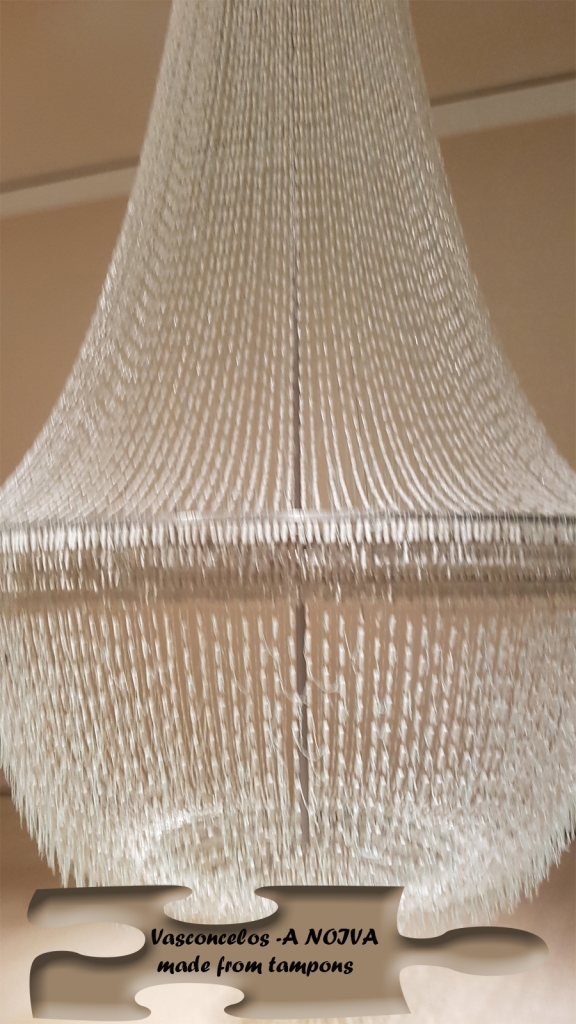
OK, one last photo – this one Narda took quickly when the guard turned around… we are criminals at heart.
[caption id="attachment_22694" align="aligncenter" width="750"]
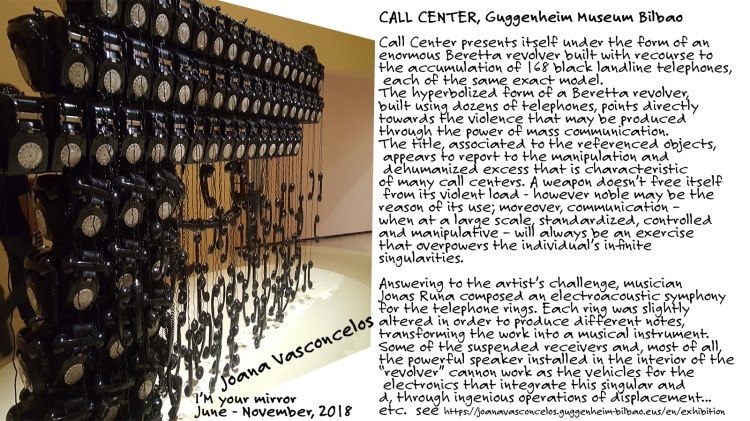 'Call Center ' Joana Vasconcelos, Guggenheim Museum Bilbao,[/caption]On the same foggy drive from Noja to Bilbao when we saw Guggenheim, we stopped at the incredible Vizcaya Bridge. It is the world's oldest transporter bridge and was built in 1893. It links the towns of Portugalete and Las Arenas crossing the mouth of the Nervion River. Look in Wikipedia for more on the Vizcaya Bridge. We walked across, later rode the transporter back. In Las Arenas, which is really just a burb of some bigger town, primarily setup for the likes of us (tourists), we attended their street fair, spent money, bought me a groovy looking leather bag, unfortunately it fell apart a month later when we were back in Adelaide. Lesson is something about being hustled that something is locally crafted in the finest leather and craftsman in Europe. Meaning, someone was able to remove the ‘made in China’ label, and sucked us in. We filmed some old blocks in costumes of some sort playing bagpipes and other instruments of torture. You will hear them in several as background in several of our clips on Spain, scattered through this tale.
'Call Center ' Joana Vasconcelos, Guggenheim Museum Bilbao,[/caption]On the same foggy drive from Noja to Bilbao when we saw Guggenheim, we stopped at the incredible Vizcaya Bridge. It is the world's oldest transporter bridge and was built in 1893. It links the towns of Portugalete and Las Arenas crossing the mouth of the Nervion River. Look in Wikipedia for more on the Vizcaya Bridge. We walked across, later rode the transporter back. In Las Arenas, which is really just a burb of some bigger town, primarily setup for the likes of us (tourists), we attended their street fair, spent money, bought me a groovy looking leather bag, unfortunately it fell apart a month later when we were back in Adelaide. Lesson is something about being hustled that something is locally crafted in the finest leather and craftsman in Europe. Meaning, someone was able to remove the ‘made in China’ label, and sucked us in. We filmed some old blocks in costumes of some sort playing bagpipes and other instruments of torture. You will hear them in several as background in several of our clips on Spain, scattered through this tale.

The Cueva de El Castillo or Cave of the Castle
Video and slideshow of the cave and Puente Viesgo http://tiny.cc/t0y23y
[embed]https://www.youtube.com/watch?v=WcJq15Z_h_w&feature=youtu.be[/embed]
We got an early morning start and drove 40 minutes to The Cueva de El Castillo, or Cave of the Castle. It is an archaeological site within the complex of the Caves of Monte Castillo, in Puente Viesgo, Cantabria, Spain. The El Castillo cave contains the oldest known cave painting. The El Castillo cave contains the oldest known cave painting: a large red stippled disk in the Panel de las Manos was dated to more than 40,000 years old. The painting below is not of the red stippled disk. I was unable to take a photo. The guide watched my every move; whether because she thought I was hot or because she saw my camera in one hand and phone in the other, and she didn’t trust me, or who knows what goes through a woman’s mind? Sucks! Nevertheless, she was good in the sense that she translated everything to us in our understandable language. We were the only non-them in the group, so it was a good effort on her part.
[caption id="attachment_22700" align="aligncenter" width="750"]
 The Cueva de El Castillo, or Cave of the Castle in the caves of Monte Castillo, in Puente Viesgo, Cantabria, Spain.[/caption]We did not go to any one of the other many caves (1600 I think) as we drove down the cave-mountain in search of food, as all hunters and gathers do. We wandered the historical village of Puente Viesgo. It was alongside the river Pas (see our video/slideshow above), and to quote Wikipedia; ‘The various populations of Puente Viesgo (Viesgo Bridge) are documented since the year 1000 by the abbey of Santillana del Mar. Bottom line, if you are in northern Spain, like caves, old stuff, visit this place. It is only 28km away from Santander, the capital, and arrival point if you take the ferry to Santander from the UK.
The Cueva de El Castillo, or Cave of the Castle in the caves of Monte Castillo, in Puente Viesgo, Cantabria, Spain.[/caption]We did not go to any one of the other many caves (1600 I think) as we drove down the cave-mountain in search of food, as all hunters and gathers do. We wandered the historical village of Puente Viesgo. It was alongside the river Pas (see our video/slideshow above), and to quote Wikipedia; ‘The various populations of Puente Viesgo (Viesgo Bridge) are documented since the year 1000 by the abbey of Santillana del Mar. Bottom line, if you are in northern Spain, like caves, old stuff, visit this place. It is only 28km away from Santander, the capital, and arrival point if you take the ferry to Santander from the UK.In the village of Puente Viesgo we found the Gran Hotel. We thought it would be too expensive for the likes of us but we got ourselves a good feed for under 20 euros each. (The Gran Hotel, https://www.balneariodepuenteviesgo.com). OK, so we dipped into the world of the millennials and took photos of our meals – such as they were, so delightfully served.
[caption id="attachment_22696" align="aligncenter" width="750"]
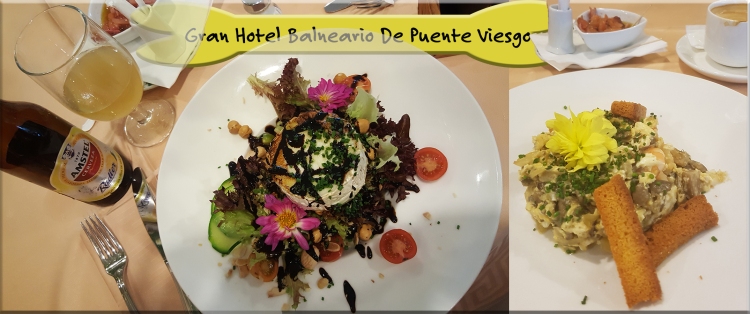 Gran Hotel Balneario De Puente Viesgo[/caption]And that was our month in Spain. Coming up in a few weeks (April 2019) is a short three-month trip with stays in Denver for a month, Florida a few weeks, upstate New York to see my sister and family, NYC, of course, and the rest of the time in DC to hang with Narda’s son and his family. Later in the year we are in Pakistan, India and Thailand and of course good old Oz. So we will scribble a bit over the year.
Gran Hotel Balneario De Puente Viesgo[/caption]And that was our month in Spain. Coming up in a few weeks (April 2019) is a short three-month trip with stays in Denver for a month, Florida a few weeks, upstate New York to see my sister and family, NYC, of course, and the rest of the time in DC to hang with Narda’s son and his family. Later in the year we are in Pakistan, India and Thailand and of course good old Oz. So we will scribble a bit over the year.
Next up will be USA. 15 April 2019 ~ 15 July 2019: Washington DC, Denver, NYC, upstate New York, Florida. Let us know if we are in the same town as you and we will have a cuppa. Count your sleeps. We are.
Thanks for sharing this moment with us.
[caption id="attachment_22710" align="alignleft" width="150"]
 homepage[/caption]e-books of Terrell Neuage updated 19/03/2019
homepage[/caption]e-books of Terrell Neuage updated 19/03/2019Terrell Neuage Thoughts 2019 updated 13 March 2019 Adelaide, South Australia
NEUAGE HOMEPAGE
picture poems are available at these sites: Twitter, ~ Tumblr ~ Pinterest updated 13 March, 2019 Adelaide, South Australia
‘Leaving Australia Book 2‘ (updated March, 2019 IN PAPERBACK & AS E-BOOK) ‘ Leaving Australia “Again’: Before the After” (updated March, 2019 See the first 30 pages of each for free) Paperback Edition

ReplyDeletetrung tâm tư vấn du học canada vnsava
công ty tư vấn du học canada vnsava
trung tâm tư vấn du học canada vnsava uy tín
công ty tư vấn du học canada vnsava uy tín
trung tâm tư vấn du học canada vnsava tại tphcm
công ty tư vấn du học canada vnsava tại tphcm
điều kiện du học canada vnsava
chi phí du học canada vnsava
#vnsava
@vnsava